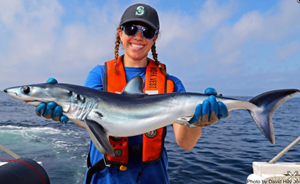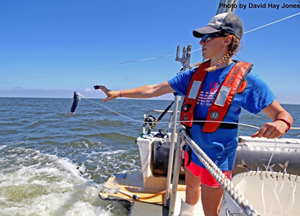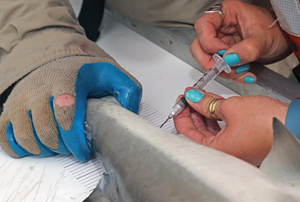
Emily displays a shortfin mako she and her team encountered while conducting longline surveys. (Provided by Emily Seubert)
Major environmental disturbances such as oil spills can alter a marine ecosystem’s structure and even cause species losses or additions in impacted areas – changes which may have long-term consequences for an ecosystem’s functions.
Emily Seubert investigates the diets of marine predators in the northern Gulf of Mexico food web to better understand how the Deepwater Horizon spill may have affected the Gulf’s functional diversity and resiliency. “It is our duty as residents of this planet to protect and care for it,” explained Emily. “The more we understand, the more knowledge we can spread to others and help protect our world.”
Emily is a marine science master’s student with the University of South Alabama and a GoMRI Scholar with the Alabama Center for Ecological Resilience (ACER).

Emily throws out a baited gangion as she sets the bottom longline. (Provided by Emily Seubert)
Her Path
Emily spent the summers of her Seattle childhood exploring Puget Sound tide pools and being awestruck by orca whale pods that would surround her family’s boat. These experiences drove her desire to study marine science. Emily completed a bachelor’s degree in biological sciences at the University of California, Davis in 2013 and began a master’s degree in marine science at the University of South Alabama and the Dauphin Island Sea Lab in 2015. Her desire to learn more about ecosystem interactions and functions sparked her interest in joining her advisor Dr. Marcus Drymon to study effects of the Deepwater Horizon oil spill on species diversity and food web interactions.
Her Work
Functional diversity refers to an ecosystem’s particular biological processes, functions, and characteristics. Previous studies have suggested that the Deepwater Horizon spill reduced the abundance and diversity of consumers at various trophic levels in the Gulf food web, likely altering ecosystem function. Community-level changes documented post-spill showed elevated numbers of predator species compared to pre-spill observations, which could indicate a restructuring of the northern Gulf food web. Emily assesses stable isotope ratios in apex predators (top of the food chain) and mesopredators to investigate the post-spill food web and quantify functional groups, which will help her identify shifts in the system’s functional diversity.

Emily (left) uses a knife to peel back the skin of a bull shark so she can use a biopsy punch to extract a sample of white muscle tissue. (Provided by Emily Seubert)
Emily extracts blood and muscle tissue samples from predatory shark, ray, and fish species collected in waters around the Chandeleur Islands, Mississippi Sound, and Mobile Bay. She analyzes the samples for carbon, nitrogen, and sulfur stable isotope ratios. Emily explained that carbon 13 – the stable isotope of carbon – does not fractionate as it moves through the food web; therefore, carbon’s stable isotope ratio is useful for identifying the source of organic matter that fuels a food web. Similarly, sulfur does not fractionate and its stable isotope ratio can help differentiate between benthic and pelagic food webs. Unlike carbon and sulfur, nitrogen does fractionate with each change in trophic level, making it a useful indicator of trophic position. The combination of these three stable isotope ratios allows Emily to identify each sampled organism’s role in the food web and determine if its functional role overlaps with other organisms.
Emily uses this information to look at the ecosystem as a whole to determine what the area’s functional diversity indicates about its resiliency after an environmental disaster. She explained that having more functionally diverse species increases an ecosystem’s resiliency to disasters: “The more functionally diverse an ecosystem, the greater its resiliency and its potential to recover from a disturbance like an oil spill. Think about an ecosystem with only three roles or trophic niches to fill, and you’ve lost one in a disaster. That ecosystem would suffer a lot more from losing one species or niche than a more robust ecosystem with ten roles or trophic niches.”

Emily uses a hypodermic needle to extract blood from the caudal vein of a blacktip shark. (Provided by Emily Seubert)
Understanding the resiliency and robustness of ecosystems can help inform recovery and restoration plans for future environmental disasters. Researchers and responders can use this information to determine which ecosystems are more vulnerable to environmental disasters and will therefore need more protection and better management. “If a disaster-affected ecosystem exhibited low numbers of apex predators and high numbers of mesopredators, we should manage our fishing pressures on those higher-level organisms,” explained Emily. “In that scenario, we can suspect that something is offsetting the balance, and relieving our fishing efforts on top predators may help bring the system back to equilibrium.”
Her Learning
Emily has found that, while the scientific process seems straightforward, learning how to juggle fieldwork, lab work, classes, presentations, and conferences can be challenging. Her ACER research provided her with valuable experience in planning, executing, and managing research and in clearly communicating her research and findings, helping her grow as a young scientist and professional. “The difference between where I started and where I am now is night and day,” said Emily. “I gain more confidence and knowledge with every obstacle and task I face. I know that I am growing as a scientist every day, surrounded by amazing mentors and a fantastic support team.”
Her Future
Emily plans to complete her master’s degree by the end of 2017 and find a position that allows her to travel and work in various labs around the country or even the world. She believes that working with different organisms, ecosystems, environments, and people can help her better understand our natural world. “As I have done throughout my career, I will continue to keep my eyes and ears open and to never stop learning,” she said.
Emily recommends that students interested in marine science should take chances and venture outside of their comfort zone. Her path took her far from home to an area she never anticipated and researching species she knew little about. However, she says she cannot imagine working with a better ecosystem, study species, or advisor for her master’s research, “I feel extremely lucky and blessed to be doing what I’m doing, and I never would be where I am if I hadn’t taken chances.”
Praise for Emily
Emily’s advisor Dr. Marcus Drymon said it has been a pleasure to work with Emily as she matures into a seasoned researcher. He praised her “palpable enthusiasm” for her research and her cheerful wit, calling her an integral part of his project. “I’m proud of the progress that Emily has made,” he said. “I see enormous potential for Emily’s work to contribute to a broader understanding of ecosystem resiliency.”
The GoMRI community embraces bright and dedicated students like Emily Seubert and their important contributions. The GoMRI Scholars Program recognizes graduate students whose work focuses on GoMRI-funded projects and builds community for the next generation of ocean science professionals. Visit the ACER website to learn more about their work.
************
The Gulf of Mexico Research Initiative (GoMRI) is a 10-year independent research program established to study the effect, and the potential associated impact, of hydrocarbon releases on the environment and public health, as well as to develop improved spill mitigation, oil detection, characterization and remediation technologies. An independent and academic 20-member Research Board makes the funding and research direction decisions to ensure the intellectual quality, effectiveness and academic independence of the GoMRI research. All research data, findings and publications will be made publicly available. The program was established through a $500 million financial commitment from BP. For more information, visit http://gulfresearchinitiative.org/.
